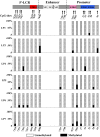Methylation of CpG sites in the upstream regulatory region, physical status and mRNA expression of HPV-6 in adult-onset laryngeal papilloma
- PMID: 29156725
- PMCID: PMC5689615
- DOI: 10.18632/oncotarget.19898
Methylation of CpG sites in the upstream regulatory region, physical status and mRNA expression of HPV-6 in adult-onset laryngeal papilloma
Abstract
The methylation status of HPV-6 upstream regulatory region (URR) in adult-onset laryngeal papillomatosis (AO-LP) remains unclear. The purpose of this study was to investigate the methylation status of URR and the physical status of HPV-6, as well as the dynamic variations of viral load and mRNA expression in AO-LP. We examined 18 specimens from 11 patients with AO-LP by real-time polymerase chain reaction (PCR), bisulfite-sequencing PCR, and amplification of papilloma oncogene transcripts. HPV-6 was identified in 9 of 11 patients (81.8%), and all the 15 specimens derived from 9 HPV-6-positive cases contained only episomal HPV-6 transcripts with intact E2. Three HPV-6-positive patients developed recurrent lesions, and HPV-6 copy numbers and mRNA expression decreased after surgical treatment. Among the 96 CpG sites (16/case), 67 (69.8%) were unmethylated, while 23 (30.2%) were heterogeneous (≥ 1 methylated CpG clone). High viral loads and episomal status of HPV-6 were frequently observed in AO-LP; thus, persistent E6/E7 mRNA expression of LR-HPV-6 may be associated with AO-LP recurrences. Hypomethylation and scattered patterns of methylated CpGs at the URR of HPV-6 were identified in AO-LP.
Keywords: adult-onset laryngeal papilloma; human papillomavirus-6; mRNA expression; methylation; physical status.
Conflict of interest statement
CONFLICTS OF INTEREST The authors declare that there are no conflicts of interest.
Figures




Similar articles
-
Methylation status of HPV16 E2-binding sites classifies subtypes of HPV-associated oropharyngeal cancers.Cancer. 2015 Jun 15;121(12):1966-76. doi: 10.1002/cncr.29315. Epub 2015 Mar 2. Cancer. 2015. PMID: 25731880
-
Human papillomavirus 16 E6/E7 transcript and E2 gene status in patients with cervical neoplasia.Mol Diagn. 2004;8(1):57-64. doi: 10.1007/BF03260048. Mol Diagn. 2004. PMID: 15230643
-
Differential methylation of E2 binding sites in episomal and integrated HPV 16 genomes in preinvasive and invasive cervical lesions.Int J Cancer. 2013 May 1;132(9):2087-94. doi: 10.1002/ijc.27906. Epub 2012 Nov 26. Int J Cancer. 2013. PMID: 23065631
-
Recurrent laryngeal papillomatosis: multimodal therapeutic strategies. Literature review and multicentre retrospective study.Acta Otorhinolaryngol Ital. 2023 Apr;43(Suppl. 1):S111-S122. doi: 10.14639/0392-100X-suppl.1-43-2023-14. Acta Otorhinolaryngol Ital. 2023. PMID: 37698108 Free PMC article. Review.
-
Adult-onset recurrent respiratory papillomatosis: a review of disease pathogenesis and implications for patient counseling.JAMA Otolaryngol Head Neck Surg. 2015 Jan;141(1):78-83. doi: 10.1001/jamaoto.2014.2826. JAMA Otolaryngol Head Neck Surg. 2015. PMID: 25393901 Review.
Cited by
-
Genomic diversity of HPV6 and HPV11 in recurrent respiratory papillomatosis: Association with malignant transformation in the lungs and clinical outcomes.Tumour Virus Res. 2024 Dec;18:200294. doi: 10.1016/j.tvr.2024.200294. Epub 2024 Oct 29. Tumour Virus Res. 2024. PMID: 39481538 Free PMC article.
-
Coordinated Expression of HPV-6 Genes with Predominant E4 and E5 Expression in Laryngeal Papilloma.Microorganisms. 2021 Mar 3;9(3):520. doi: 10.3390/microorganisms9030520. Microorganisms. 2021. PMID: 33802595 Free PMC article.
-
Development of Antibodies against HPV-6 and HPV-11 for the Study of Laryngeal Papilloma.Viruses. 2021 Oct 7;13(10):2024. doi: 10.3390/v13102024. Viruses. 2021. PMID: 34696453 Free PMC article.
-
Association between human papillomavirus particle production and the severity of recurrent respiratory papillomatosis.Sci Rep. 2023 Apr 6;13(1):5514. doi: 10.1038/s41598-023-32486-8. Sci Rep. 2023. PMID: 37024540 Free PMC article.
-
HPV-Associated Benign Squamous Cell Papillomas in the Upper Aero-Digestive Tract and Their Malignant Potential.Viruses. 2021 Aug 17;13(8):1624. doi: 10.3390/v13081624. Viruses. 2021. PMID: 34452488 Free PMC article. Review.
References
-
- Tommasino M. The human papillomavirus family and its role in carcinogenesis. Semin Cancer Biol. 2014;26:13–21. - PubMed
-
- Derkay CS, Darrow DH. Recurrent respiratory papillomatosis. Ann Otol Rhinol Laryngol. 2006;115:1–11. - PubMed
-
- Kashima H, Mounts P, Leventhal B, Hruban RH. Sites of predilection in recurrent respiratory papillomatosis. Ann Otol Rhinol Laryngol. 1993;102:580–83. - PubMed
-
- Duggan MA, Lim M, Gill MJ, Inoue M. HPV DNA typing of adult-onset respiratory papillomatosis. Laryngoscope. 1990;100:639–42. - PubMed
LinkOut - more resources
Full Text Sources
Other Literature Sources

